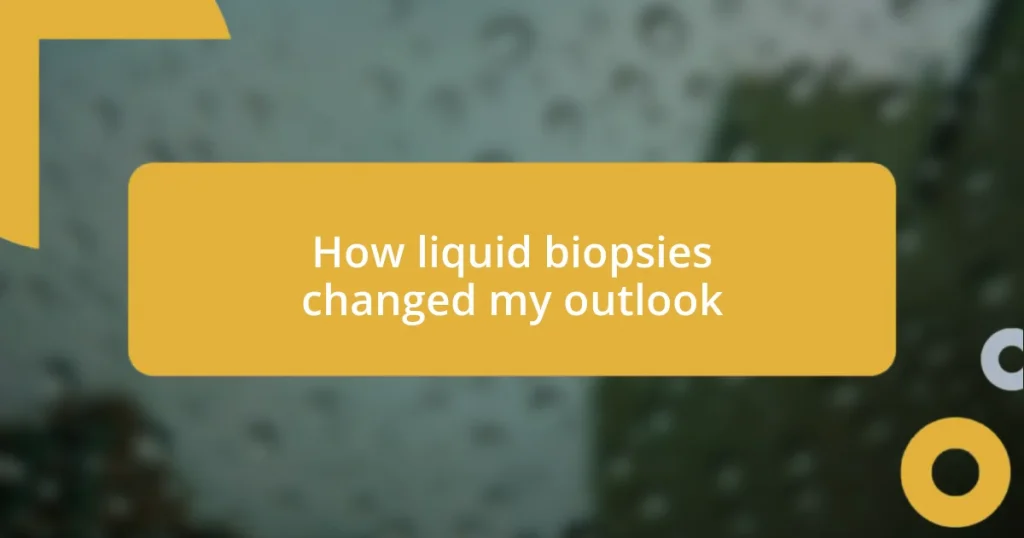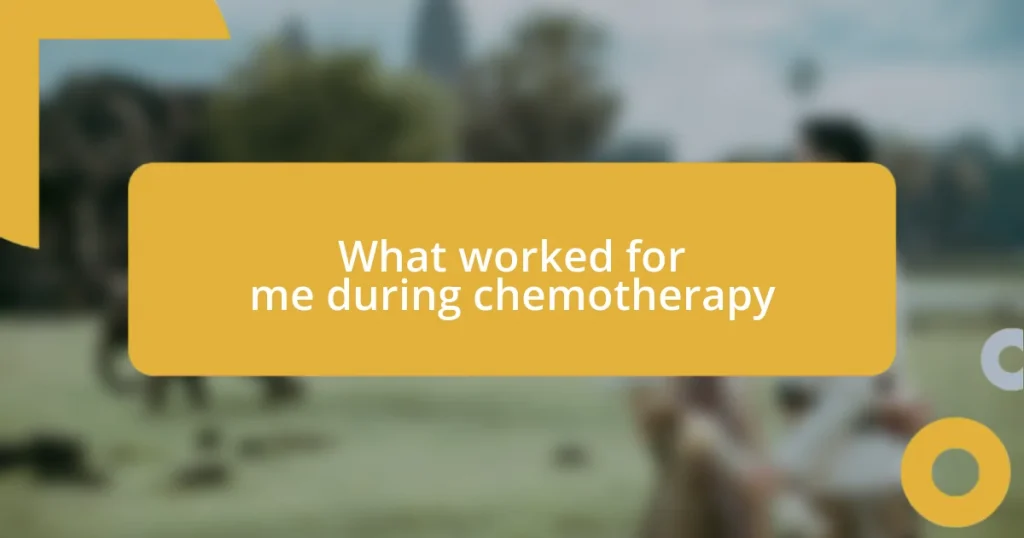Key takeaways:
- Liquid biopsies offer a non-invasive alternative to traditional biopsies, using blood samples to gather crucial cancer-related information, reducing patient anxiety and discomfort.
- This technology allows for real-time monitoring of cancer treatment and adaptation of therapies based on circulating tumor DNA (ctDNA), improving personalized medicine outcomes.
- The future of liquid biopsies includes advancements in early cancer detection, integration with artificial intelligence for predictive treatment, and potential applications in diagnosing other diseases beyond oncology.

Understanding liquid biopsies
Liquid biopsies represent a groundbreaking advancement in cancer detection and monitoring. Unlike traditional biopsies, which involve invasive procedures to obtain tissue samples, liquid biopsies utilize blood samples to capture circulating tumor DNA (ctDNA) and other biomolecules. The non-invasive nature of this method deeply resonates with me, as I can’t help but wonder how many patients, like myself, found solace in knowing that a simple blood draw could provide critical insights into their health.
From my perspective, the idea that you can glean so much information from just a vial of blood feels almost miraculous. I’ve personally witnessed the anxiety that often accompanies the thought of undergoing invasive procedures. Just thinking about those moments of uncertainty brings back vivid memories—like waiting in a hospital gown, apprehensive about what the doctors might discover. Liquid biopsies have the potential to alleviate that stress, making the process of monitoring cancer not only easier but also more compassionate.
Moreover, the implications of liquid biopsy technology extend beyond mere convenience. It opens doors for real-time monitoring of treatment responses and the dynamic nature of cancer. For instance, I recall hearing about a friend whose treatment regimen was adjusted based on the findings from a liquid biopsy—a change that ultimately led to better outcomes. It makes me wonder, how many lives could be transformed with this kind of personalized approach to healthcare?

The science behind liquid biopsies
Liquid biopsies work by isolating circulating tumor DNA (ctDNA) from a patient’s blood, providing a wealth of information about the tumor’s genetic makeup without the need for surgery. This method has revolutionized cancer diagnostics, enabling earlier detection and real-time assessment of treatment efficacy. When I learned about ctDNA, I couldn’t help but be fascinated; the thought that a few milliliters of blood could hold crucial clues about cancer felt both empowering and surreal.
As I dove deeper into the science, I realized that liquid biopsies are not just about identifying mutations. They also track the evolution of cancer over time, allowing oncologists to tailor treatments to patients’ specific needs. When my oncologist explained how ctDNA could detect resistance to therapy, I felt a surge of hope; this technology offers an adaptive approach, almost like a chess match between disease and treatment strategies. It brings a sense of control to an otherwise unpredictable journey.
Moreover, researchers are continually improving liquid biopsy techniques, making them more sensitive and specific. For instance, studies have shown that liquid biopsies can detect cancer recurrence often months before traditional imaging methods. I remember thinking about my own journey, wondering if this technology could have alerted me sooner to changes in my health. It’s innovations like these that inspire me to remain optimistic about the future of personalized medicine.
| Traditional Biopsy | Liquid Biopsy |
|---|---|
| Invasive Procedure | Non-Invasive |
| Tissue Sample Required | Blood Sample Sufficient |
| Static Information | Dynamic Monitoring |

Personal stories with liquid biopsies
When I think about my first encounter with liquid biopsies, I remember the day vividly. Sitting in the waiting room, I felt a strange mix of apprehension and hope. Just a week prior, I had undergone a traditional biopsy, and the thought of another invasive procedure made my stomach churn. But when my doctor mentioned that we could use a simple blood test instead, I felt a wave of relief wash over me. It was astonishing to imagine that insights into my health could be gleaned without the need for a needle in my side.
One story that sticks with me is of a close family member. They were battling cancer and faced numerous invasive procedures that left them feeling drained, both physically and emotionally. When their oncologist suggested a liquid biopsy, it was like a breath of fresh air. The ability to monitor their condition with minimal discomfort transformed their outlook. They often reflected on how empowering it felt to be able to collect vital information without the added stress of hospitalization.
- The ease of a blood draw compared to invasive procedures changed my perspective on treatment.
- Healing through liquid biopsies allowed my family member to feel more in control of their journey.
- The emotional weight lifted, knowing we could gather crucial data without painful procedures, was priceless.
- Observing the real-time adjustments to treatment based on liquid biopsy results highlighted the potential of personalized medicine.

Future trends in liquid biopsies
As I look ahead, I can’t help but feel excited about the advancements in liquid biopsies, particularly in their ability to assist in early cancer detection. Imagine the possibility of a routine blood test performed during a regular check-up that could detect anomalies before symptoms even arise. Personally, I believe that having this kind of proactive approach could significantly change how we manage our health and potentially save lives.
There’s also a growing interest in the integration of artificial intelligence with liquid biopsy data. With machine learning algorithms analyzing patterns within circulating tumor DNA, we could see a future where personalized treatments are not just reactive but predictive. I often think about how this could have influenced my treatment choices, allowing for adjustments based on data-driven insights rather than waiting for a response to existing therapies.
Finally, the prospect of liquid biopsies expanding beyond oncology intrigues me. Early research suggests that they could eventually be applied to diagnose other diseases, such as autoimmune disorders and infectious diseases. Can you imagine a world where a simple blood test could provide answers across various health challenges? Embracing this technology feels like a key to unlocking a future where healthcare is not only more efficient but profoundly more empathetic, aligning with our deepest hopes for holistic patient care.















